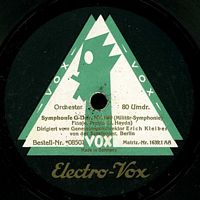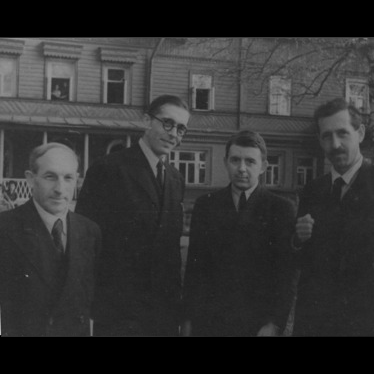Étiquette : Ravel
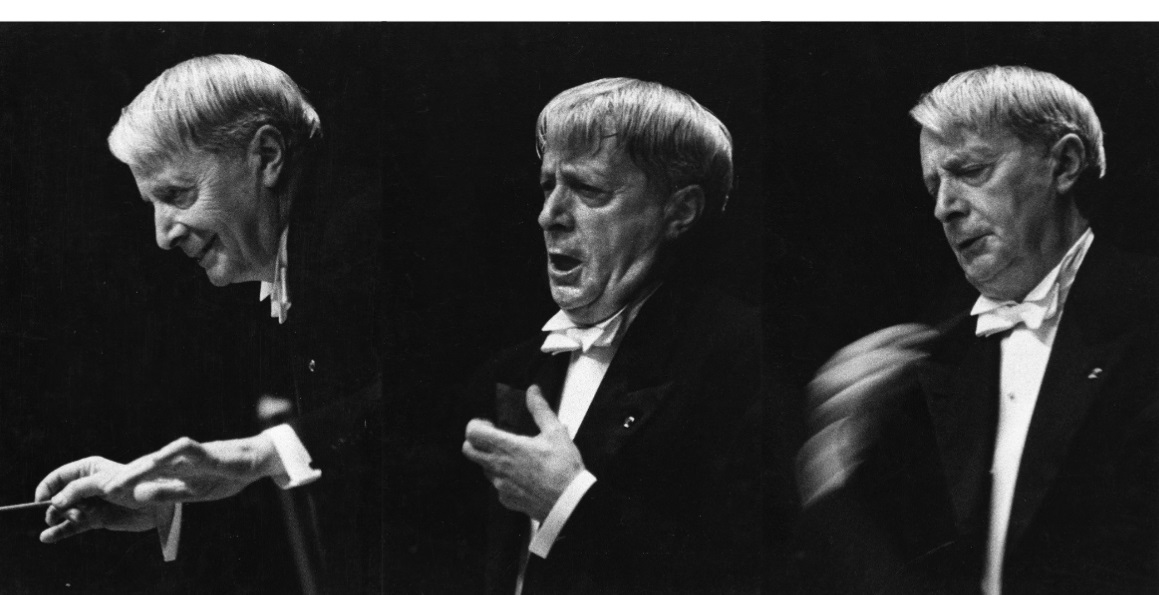
Charles Munch Ravel
Orchestre National de la RTF (ON)
Tombeau de Couperin
Festival de Besançon – Théâtre Municipal 2 Septembre 1954
______
Boston Symphony Orchestra (BSO)
Ma Mère l’Oye (suite)
Boston Symphony Hall January 31, 1958
La Valse
Boston Symphony Hall December 6, 1957
La Valse Répétition/Rehearsal
Boston Symphony Hall February 12, 1950
______
Bonus: Charles Munch – Interview (1964)
Source Bande/Tape : 2 pistes/19 cm/s / 2 tracks 7.5 ips MONO
Charles Munch a dirigé 24 fois le ‘Tombeau de Couperin avec le BSO entre 1950 et 1961, mais il n’en a pas laissé de version discographique. On en connaît un enregistrement public du 17 octobre 1953 avec le BSO, publié par WHRA, dans lequel les variations de tempo peuvent paraître exagérées. Cette version avec l’Orchestre National de la Radiodiffusion-Télévision Française (RTF), souvent appelé ‘l’ON’ provient du concert d’ouverture du Septième Festival de Besançon 1954, donné au Théâtre Municipal. On possède peu d’enregistrements réalisés dans ce Théâtre conçu par l’architecte Claude-Nicolas Ledoux – il a été inauguré en 1784 -et renommé pour son acoustique. En effet, il a été entièrement détruit par un incendie en avril 1958, et s’il a été reconstruit, ce fut très rapidement pour assurer une continuité.
A Boston, Munch n’a donné que 6 fois la Suite de ‘Ma Mère l’Oye’, en janvier-février 1958, mais il en a cependant réalisé un enregistrement discographique le 19 février.
La Valse a été jouée 56 fois par Munch et le BSO entre 1950 et 1966, et avec cet orchestre, il l’a enregistré trois fois pour le disque (11 avril 1950, 5 décembre 1955 et 26 mars 1962). L’extrait de la répétition de 1950 nous montre quel niveau d’intensité Munch pouvait atteindre. L’enregistrement de concert du 6 décembre 1957 est semble-t-il inédit.

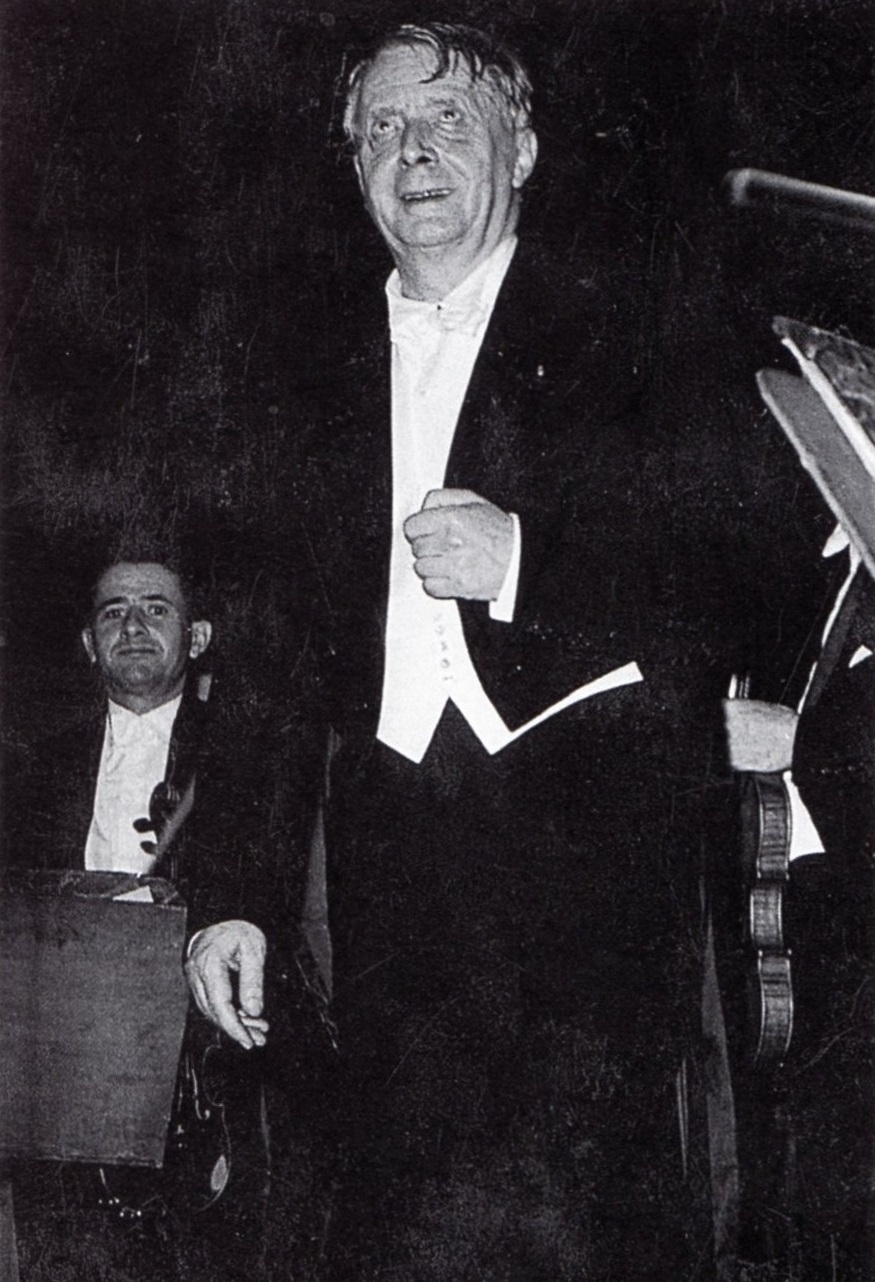
Munch Festival de Strasbourg 1954
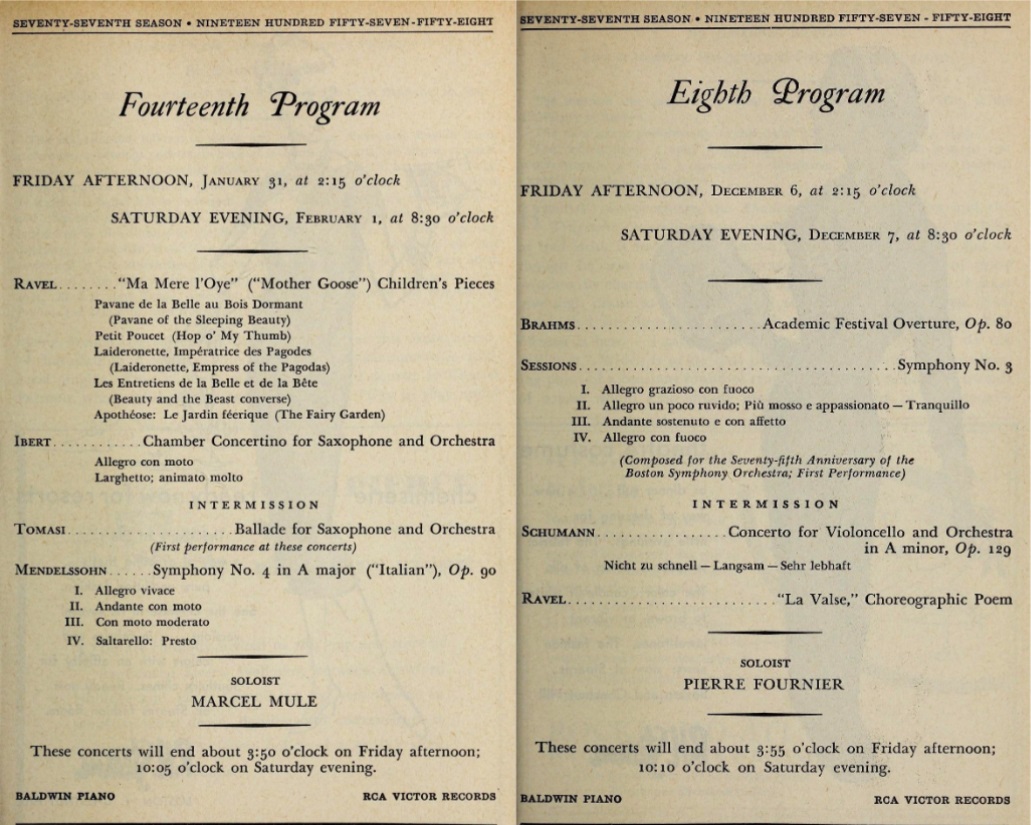
Charles Munch conducted the ‘Tombeau de Couperin’ 24 times with the BSO between 1950 and 1961, but he left no commercial recording of it. We know of a public recording of October 17, 1953 with the BSO, published by WHRA, in which the tempo variations may seem exaggerated. This version with the Orchestre National de la Radiodiffusion-Télévision Française (RTF), often called ‘l’ON’, comes from the opening concert of the Seventh Besançon Festival 1954, given at the Théâtre Municipal. Few recordings made in this Theatre, designed by architect Claude-Nicolas Ledoux – it was inaugurated in 1784 – and renowned for its acoustics, have survived. In fact, it was completely destroyed by fire in April 1958, and if it was rebuilt, it was very quickly to ensure continuity.
In Boston, Munch performed the Suite from ‘Ma Mère l’Oye’ only 6 times, in January-February 1958, although he did make a commercial recording of it on February 19.
‘la Valse’ was performed 56 times by Munch and the BSO between 1950 and 1966, and with this orchestra he recorded it three times for disc (April 11, 1950, December 5, 1955 and March 26, 1962). The excerpt from the 1950 rehearsal shows us the level of intensity Munch could achieve. The concert recording of December 6, 1957 appears to be unpublished.
Les liens de téléchargement sont dans le premier commentaire. The download links are in the first comment
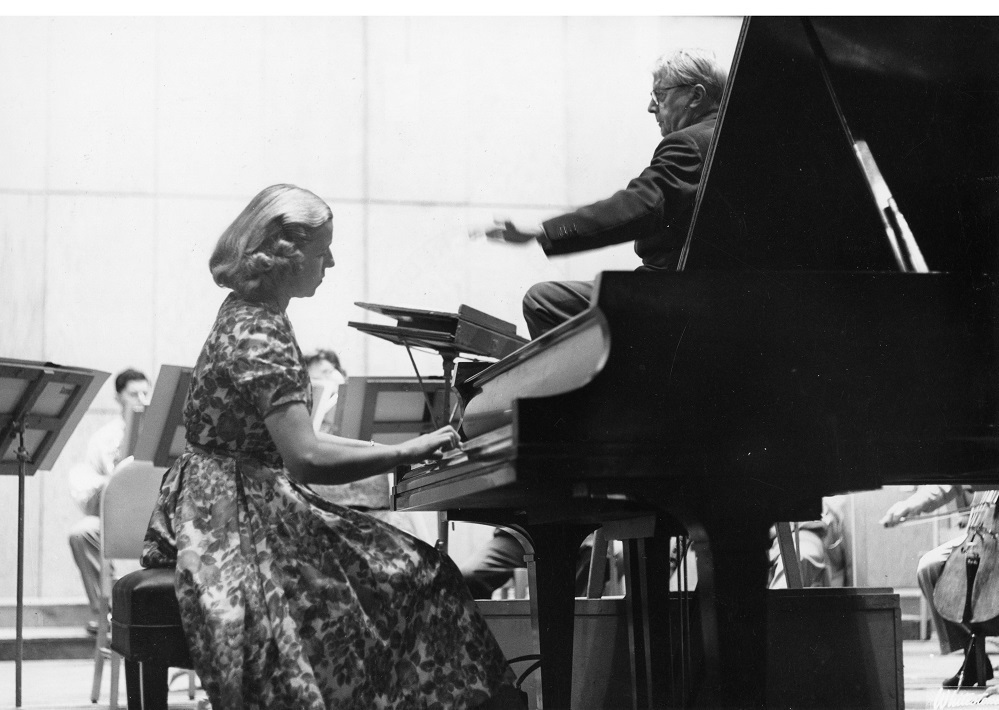
Meilleurs Vœux pour 2024 / Best Wishes for 2024
Charles Munch – Boston Symphony Orchestra (BSO)
Fauré: Ballade Op.19 – Ravel: Concerto en sol
Nicole Henriot-Schweitzer, Baldwin Piano
Cor Anglais/English Horn: Louis Speyer (Ravel)
Boston Symphony Hall – April 2, 1960
Ravel Tzigane Joseph Silverstein, violin
Boston Symphony Hall – October 17, 1959
Ravel Rapsodie Espagnole
Boston Symphony Hall – February 19, 1965
Source Bande/Tape: 2 pistes/19cm/s / 2 tracks 7.5 ips STEREO
Parmi les enregistrements de ce programme, seule la Ballade de Fauré a fait l’objet d’une publication. Munch n’a pas fait d’enregistrement commercial de cette œuvre, et celui-ci, très réussi, est le seul recensé sous sa direction avec un concert en 1965 avec l’Orchestre de Leningrad, n’en est que plus précieux.
L’exécution du Concerto en sol de Ravel, joué le même jour que la Ballade de Fauré, est particulièrement dynamique, et l’impétuosité de Munch conduit à un épisode humoristique inattendu à la fin du premier mouvement.
Nicole Henriot-Schweitzer (1923-2001) a donné de nombreux concerts sous la direction de Munch. Pour s’en tenir au BSO, on relève le Concerto n°2 de Brahms (1951), la Ballade de Fauré (1952, 1960), les Variations Symphoniques de Franck (1965), la Symphonie sur un Chant Montagnard de d’Indy (1958), le Concerto n°1 de Liszt (1951), la Suite Concertante de Milhaud (1953), le Concerto n°17 K.453 de Mozart (1959), le Concerto n°2 de Prokofiev (1957, 1962), le Concerto en sol de Ravel (1950, 1951, 1952, 1958, 1960, 1964 et 1965), le Concerto n°3 de Saint-Saëns (1953) et le Concerto de Schumann (1952). Munch et Henriot-Schweitzer ont enregistré trois fois le Concerto de Ravel (OSCC 1949, BSO 1958 et Orchestre de Paris 1968).
On peut lire dans une note biographique sur Charles Munch qu’il aurait été le neveu d’Albert Schweitzer. Il n’en est rien. La sœur de Charles Munch, Emma Munch, a épousé le frère d’Albert Schweitzer. En 1958, leur fils, l’amiral Jean-Jacques Schweitzer (1920-1993), qui était donc le neveu à la fois d’Albert Schweitzer et de Charles Munch, a épousé la pianiste Nicole Henriot (1923-2001).
On connaît un enregistrement public de Tzigane de Ravel par Charles Munch et Ginette Neveu avec le NYPO le 2 janvier 1949. Ici, avec Joseph Silverstein, le public a pu apprécier celui qui allait succéder sous peu à Richard Burgin comme Concertmaster de l’orchestre.
Munch a fait quatre enregistrements commerciaux de la Rapsodie Espagnole (OSCC 1941 inédit, BSO 1950 et 1956, et Orchestre de Paris 1968). Il existe également un enregistrement public (BSO 1955) publié par WHRA. Cet extrait de concert de 1965 fait donc le ‘pont’ entre les prestations de 1956 et de 1968.
Louis Speyer, né à Paris en 1890, a étudié au Conservatoire et, en 1911, il est devenu oboïste de l’Orchestre des Concerts Colonne qui accompagnait notamment les représentations des Ballets Russes et a donc participé à des Premières d’œuvres de Ravel et de Stravinski. Il a ensuite fait partie de l’Orchestre du Théâtre ds Champs-Élysées qui a joué sous la direction de Pierre Monteux lors de la Première du Sacre du Printemps en 1913. Il s’est ensuite rendu aux États-Unis en 1918. C’est Henri Rabaud qui l’a recruté au BSO comme cor anglais solo à partir de 1919, poste qu’il a conservé jusqu’à sa retraite en 1964. Il est devenu citoyen américain en 1923. Il est décédé à Boston en 1980.
Joseph Silverstein est né à Detroit en 1932. Au Curtis Institute of Music de Philadelphie, il a étudié avec notamment Efrem Zimbalist, William Primrose, Josef Gingold et Mischa Michakoff. Il a ensuite joué dans les orchestres de Denver, Houston et Philadelphie. En 1955, il a intégré les seconds violons du BSO. En 1959, il a obtenu à Bruxelles la médaille d‘argent du concours Reine Elisabeth de Belgique. A partir de 1962, il est devenu ‘Concertmaster’ du BSO, poste qu’il a quitté en 1984 pour démarrer une carrière de chef d’orchestre. Il a été le Directeur Musical de l ‘Utah Symphony’ de 1984 à 1998 et ensuite du Florida Philharmonic Orchestra jusqu’en 2003. Il a également enseigné le violon à Boston et au Curtis Institute of Music. Il est décédé en 2015.
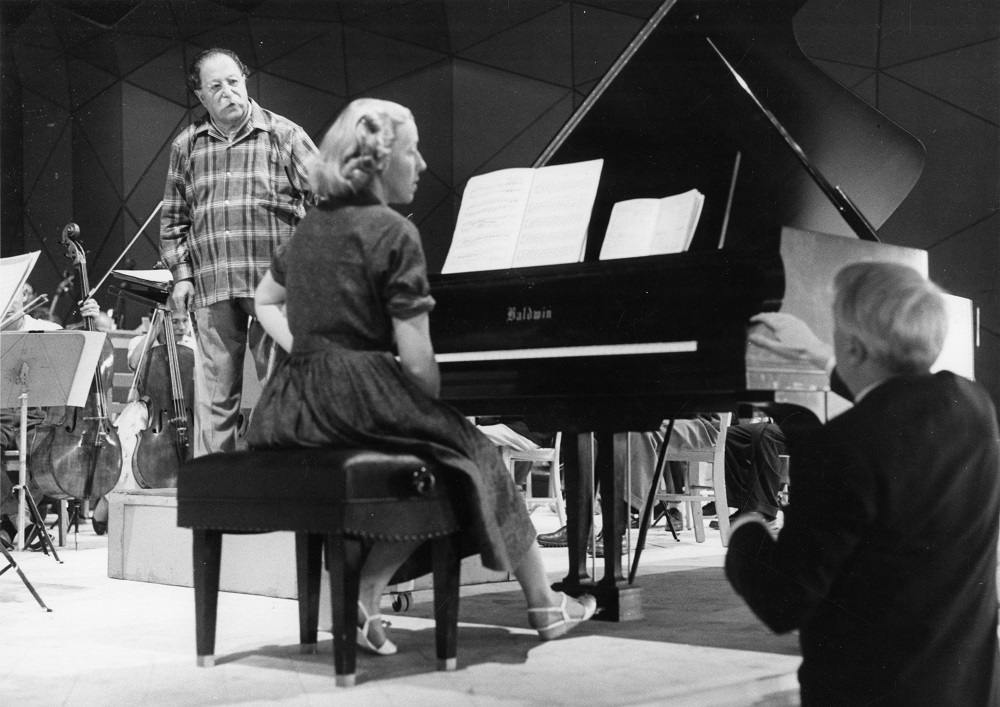
Monteux Henriot-Schweitzer Munch Tanglewood 1959

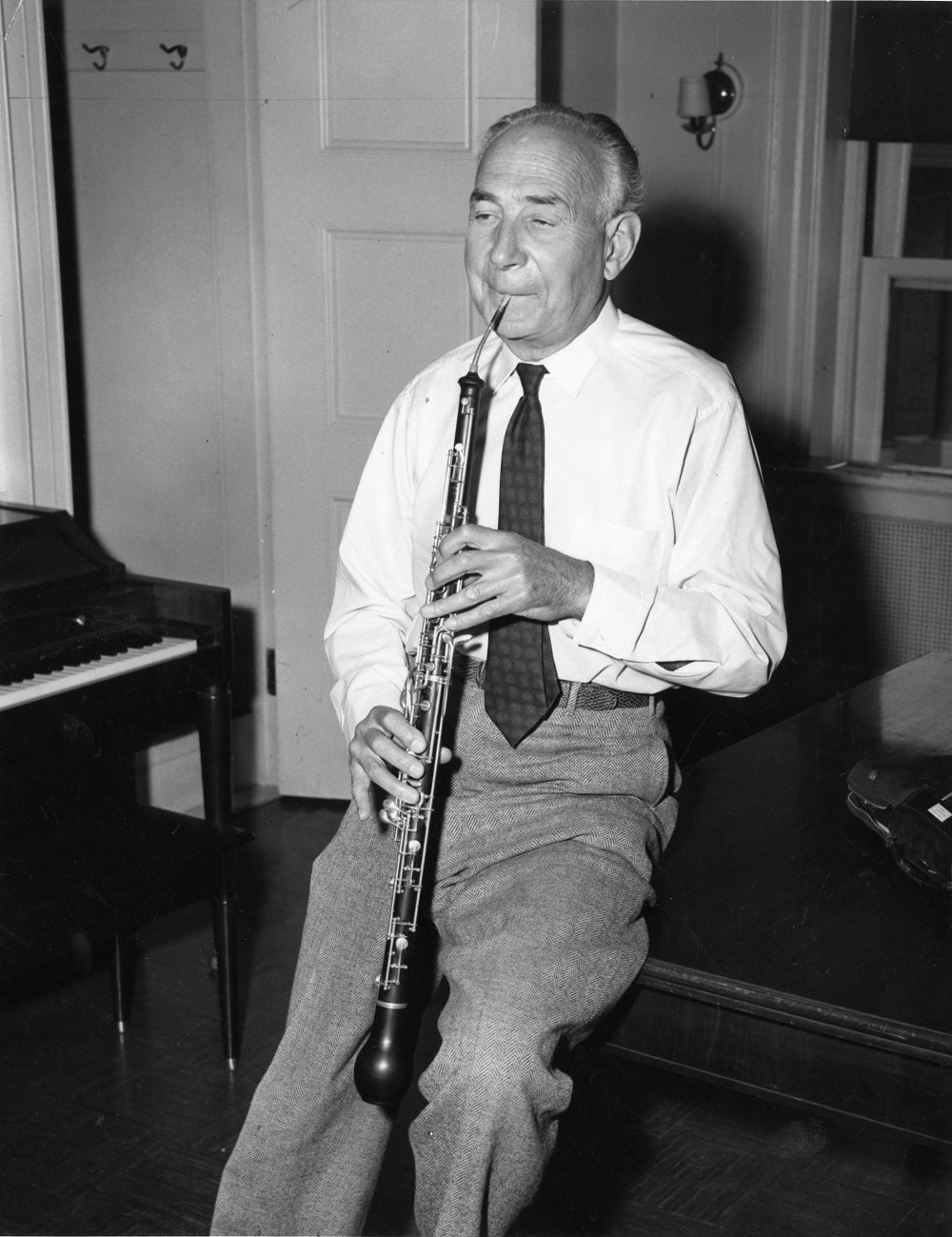
Louis Speyer
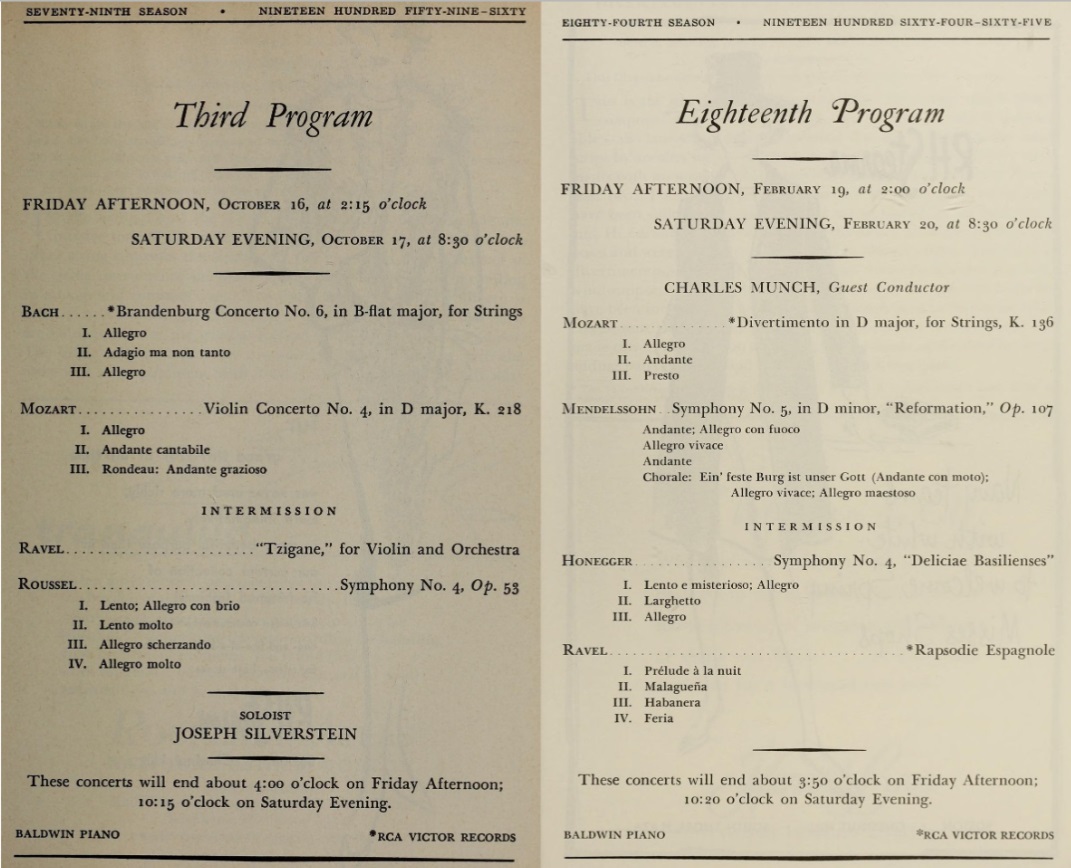
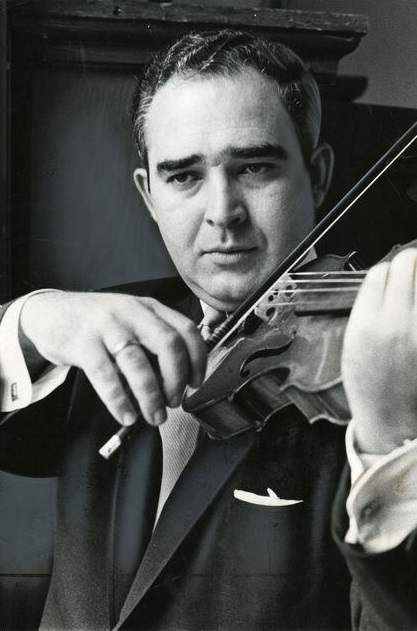
Joseph Silverstein
Of the recordings on this program, only Fauré’s Ballade has been published. Munch made no commercial recordings of this work, and this one, the only one recorded under his direction together with a 1965 concert with the Leningrad Philharmonic, is all the more valuable for that.
The performance of Ravel’s Concerto in G, played on the same day as Fauré’s Ballade, is particularly dynamic, and Munch’s impetuosity leads to an unexpected humorous episode at the end of the first movement.
Nicole Henriot-Schweitzer (1923-2001) gave many concerts under Munch’s direction. Among her BSO performances with him are Brahms’ Concerto no. 2 (1951), Fauré’s Ballade (1952, 1960), Franck’s Variations Symphoniques (1965), d’Indy’s Symphonie sur un Chant Montagnard (1958), Liszt’s Concerto no. 1 (1951), Milhaud’s Suite Concertante (1953), Mozart’s Concerto no. 17 K.453 (1959), Prokofiev Concerto No. 2 (1957, 1962), Ravel Concerto in G (1950, 1951, 1952, 1958, 1960, 1964 and 1965), Saint-Saëns Concerto No. 3 (1953) and Schumann Concerto (1952). Munch and Henriot-Schweitzer have made three recordings of Ravel’s Concerto (OSCC 1949, BSO 1958 and Orchestre de Paris 1968).
A biographical note on Charles Munch claims that he was Albert Schweitzer’s nephew. This is not true. Charles Munch’s sister Emma Munch married Albert Schweitzer’s brother. In 1958, their son, Admiral Jean-Jacques Schweitzer (1920-1993), who was therefore the nephew of both Albert Schweitzer and Charles Munch, married pianist Nicole Henriot (1923-2001).
There is a live recording of Ravel’s Tzigane by Charles Munch and Ginette Neveu with the NYPO on January 2, 1949. Here, with Joseph Silverstein, the public was able to appreciate the man who would shortly succeed Richard Burgin as the orchestra’s Concertmaster.
Munch made four commercial recordings of the Rapsodie Espagnole (OSCC 1941 unreleased – BSO 1950 and 1956, and Orchestre de Paris 1968). There is also a public recording (BSO 1955) published by WHRA. This 1965 concert excerpt bridges the gap between the 1956 and 1968 performances.
Louis Speyer, born in Paris in 1890, studied at the Paris Conservatoire and, in 1911, became an oboist with the Orchestre des Concerts Colonne, which, among others, accompanied performances of the Ballets Russes, and thus he took part in Premières of works by Ravel and Stravinsky. He then joined the Orchestre du Théâtre des Champs-Élysées, which performed under Pierre Monteux at the 1913 Première of The Rite of Spring. He then went to the United States in 1918. It was Henri Rabaud who recruited him to the BSO as principal English horn from 1919, a position he held until his retirement in 1964. He became an American citizen in 1923. He died in Boston in 1980.
Joseph Silverstein was born in Detroit in 1932. At the Curtis Institute of Music in Philadelphia, he studied among others with Efrem Zimbalist, William Primrose, Josef Gingold and Mischa Michakoff. He went on to play in the Denver, Houston and Philadelphia orchestras. In 1955, he joined the second violins of the BSO. In 1959, he won the silver medal at the Queen Elisabeth Competition in Brussels. In 1962, he became the Concertmaster of the BSO, a position he left in 1984 to embark on a career as a conductor. He was Music Director of the Utah Symphony from 1984 to 1998 and then of the Florida Philharmonic Orchestra until 2003. He also taught violin in Boston and at the Curtis Instutute of Music. He passed away in 2015.
Les liens de téléchargement sont dans le premier commentaire. The download links are in the first comment
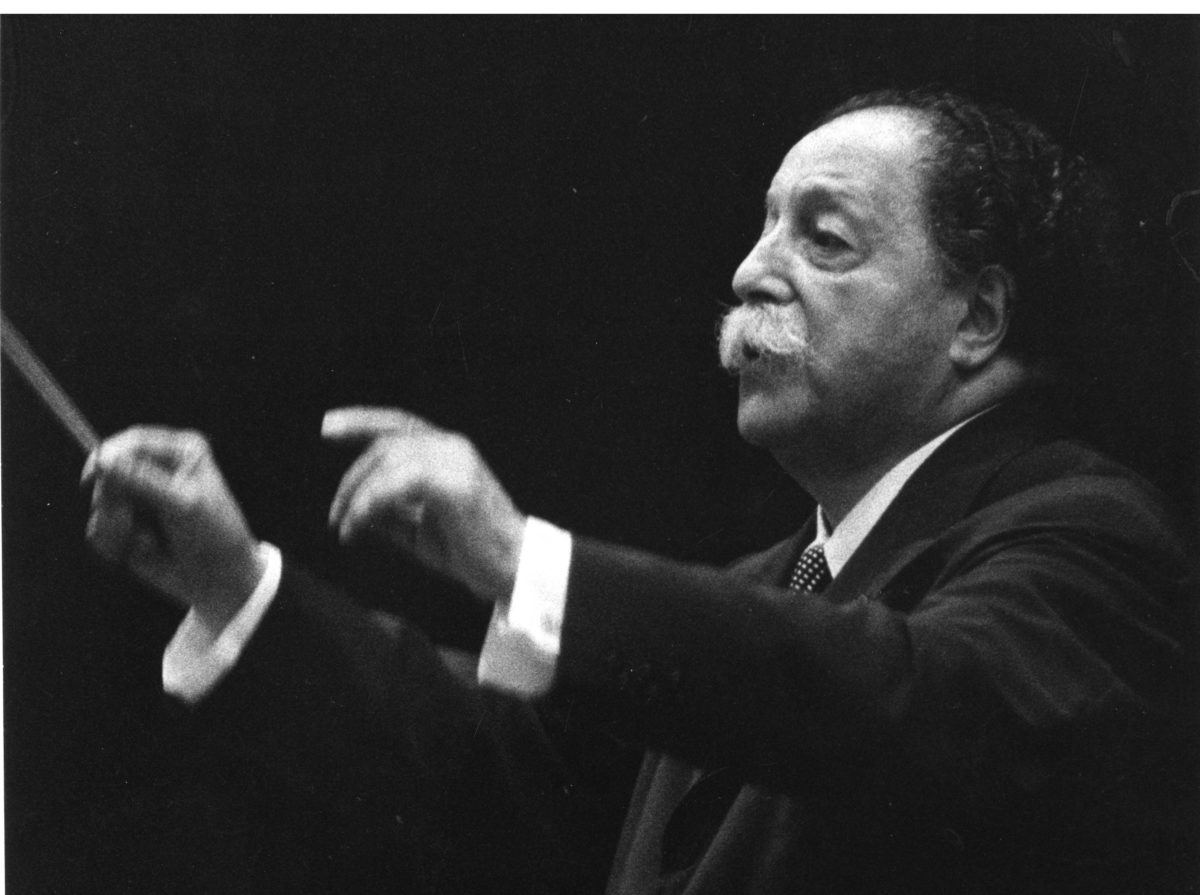
Pierre Monteux – New York Philharmonic (NYPO)
Ravel Tombeau de Couperin – Rapsodie Espagnole – Daphnis & Chloé Suites n°1 (Nocturne – Interlude – Danse guerrière) & 2 (Lever du Jour – Pantomime – Danse Générale)
Carnegie Hall – March 7, 1959
Source Bande /Tape: 2 pistes 19cm/s / 2tracks 7.5 ips
La discographie ravélienne officielle de Pierre Monteux est incomplète et en grande partie tardive (aucun enregistrement pour le disque entre 1947 et 1959). On connaît des enregistrements commerciaux avec l’Orchestre Symphonique de Paris (OSP), le San Francisco SO (SFSO), et le London Symphony Orchestra(LSO) et le 33 tours Ravel de 1964 a été son tout dernier disque. A Boston, il n’a jamais été invité à diriger pendant l’ère Koussevitzky. A partir de 1951, il a été en pratique le premier chef invité de l’orchestre. Mais, au concert comme au disque, Ravel, comme Berlioz, appartenaient en premier lieu à Munch. Quant à l’Orchestre de la Société des Concerts du Conservatoire (OSCC), Monteux n’a pas voulu poursuivre sa collaboration avec cet orchestre après sa série Stravinsky de 1956*.
Monteux n’a jamais enregistré le Tombeau de Couperin pour le disque. La présente version avec le NYPO nous paraît supérieure à sa prestation avec le BBC SO (11 Octobre 1961). On peut regretter également de ne pas avoir d’enregistrement des deux Concertos pour piano qu’il avait pourtant à son répertoire.
Monteux a enregistré l’intégrale du ballet Daphnis et Chloé en 1959 avec le LSO et les Chœurs de Covent Garden. A San Francisco, il avait déjà enregistré en 1946 la suite n°1, avec dans l’Interlude, un chœur (non crédité dans les rééditions)**. Ce concert new yorkais avec les Suites n°1 et 2 (sans le chœur) est unique dans sa discographie. L’Interlude est donc donné dans sa version purement orchestrale***, très différente de celle de la version discographique de 1946. On notera également que les deux Suites sont jouées ‘attacca’.
Le concert Ravel avec le NYPO comportait également deux œuvres (Bach et Berlioz) jouées par Joseph Szigeti. A l’époque, sa technique n’était plus du tout ce qu’elle avait été, et le grand violoniste est ici à son désavantage, ce que la critique n’a pas manqué de relever. On ne sait pas si le concert du dimanche 8 mars, dont le programme est différent, a été diffusé, ni si un enregistrement en a été conservé.
* Dans son livre « Putting the Record Straight », John Culshaw écrit à propos des enregistrements réalisés par Decca et l’OSCC : ‘Knappertsbusch n’était pas enclin à forcer les musiciens s’ils n’étaient pas d’humeur à donner le meilleur d’eux-mêmes. Solti s’est battu contre l’orchestre, qui l’a payé de retour. Ils l’ont rendu fou en envoyant des suppléants pour jouer des passages qui avaient déjà été répétés, mais nous avons quand même réussi à terminer son programme avec du temps devant nous… Monteux était économe de mots et de gestes, mais il pouvait obtenir ce qu’il voulait d’un orchestre – même si, après nos premières sessions à Paris, lorsque nous avons enregistré ‘Le Sacre’ et ‘Petrouchka’, il a dit qu’il serait plus heureux si nos futurs projets pouvaient être organisés à Londres, Amsterdam ou Vienne. Même avec un musicien aussi distingué que Monteux à la tête de l’orchestre, la discipline de l’Orchestre du Conservatoire à cette époque était épouvantable, et le système de « remplacement » tout aussi aléatoire qu’il l’avait été avec Solti.
** Le programme de la paire de concerts des 15 et 16 mars 1946, qui ont précédé de peu l’enregistrement avec le San Francisco Symphony Orchestra (SFSO) , mentionne ‘Symphonic Fragments from Daphnis and Chloe First Series’ (Nocturne – Interlude – Warlike Dance) avec le ‘University of California Chorus’, Pr. Edward B. Lawton, Director. Dans le livre de Doris Monteux ‘It’s All in the Music – The Life and Work of Pierre Monteux’, le chœur de l’enregistrement avec le SFSO est identifié comme étant le ‘San Francisco Municipal Chorus’.
*** Monteux a joué la version orchestrale des Suites n°1 et 2 avec le SFSO les 4 et 5 avril 1941, mais en omettant l’Interlude de la Suite n°1. Charles Munch a enregistré les deux Suites à Londres avec l’OSCC le 9 octobre 1946, également en omettant l’Interlude. Wilhelm Furtwängler a laissé un enregistrement des deux Suites avec le BPO (20/21 mars 1944), mais la Suite n°1 commence au milieu de l’Interlude (quelques mesures avant le solo de flûte), et on suppose que l’omission du Nocturne et du début de l’Interlude est due à la perte d’une partie de l’enregistrement.
Ravel par Monteux (enregistrements commerciaux) / Ravel by Monteux (commercial recordings):
-Alborada del gracioso SFSO (December 22, 1947)
-Boléro LSO (Wembley Town Hall – February 22-26, 1964)
-Daphnis & Chloé Intégrale / Complete LSO Ch Covent Garden (Kingsway Hall – April 27 & 28, 1959); Suite n°1 SFSO San Francisco Municipal Chorus (War Memorial Opera House – April 3, 1946)
-Ma Mère l’Oye Intégrale / Complete LSO (Wembley Town Hall – February 22-26, 1964); n°2 Petit Poucet OSP (Salle Pleyel -January 31, 1930)
-Pavane pour une Infante défunte LSO (Kingsway Hall – December 11-13, 1961)
-Rapsodie Espagnole LSO (Kingsway Hall – December 11-13, 1961)
La Valse OSP (January 30, 1930); SFSO (April 21, 1941); LSO (Wembley Town Hall – February 22-26, 1964)
Valses Nobles et Sentimentales SFSO (War Memorial Opera House – April 3, 1946)
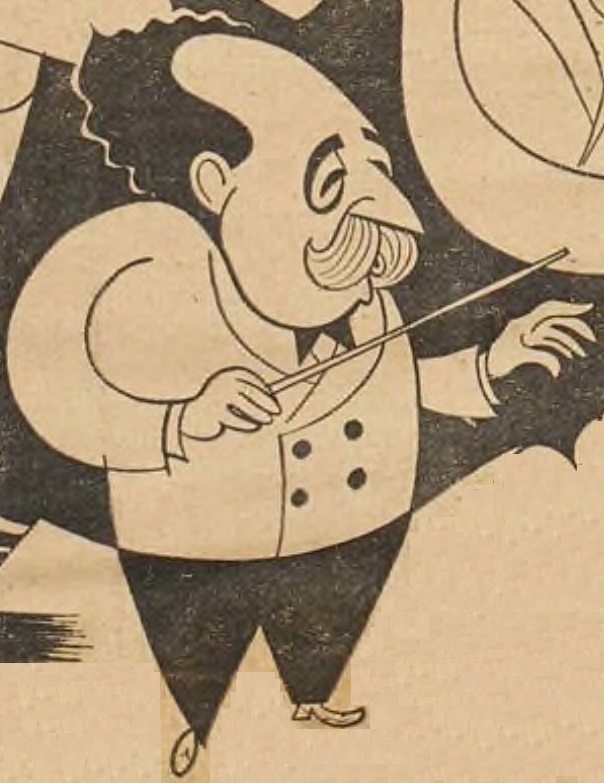
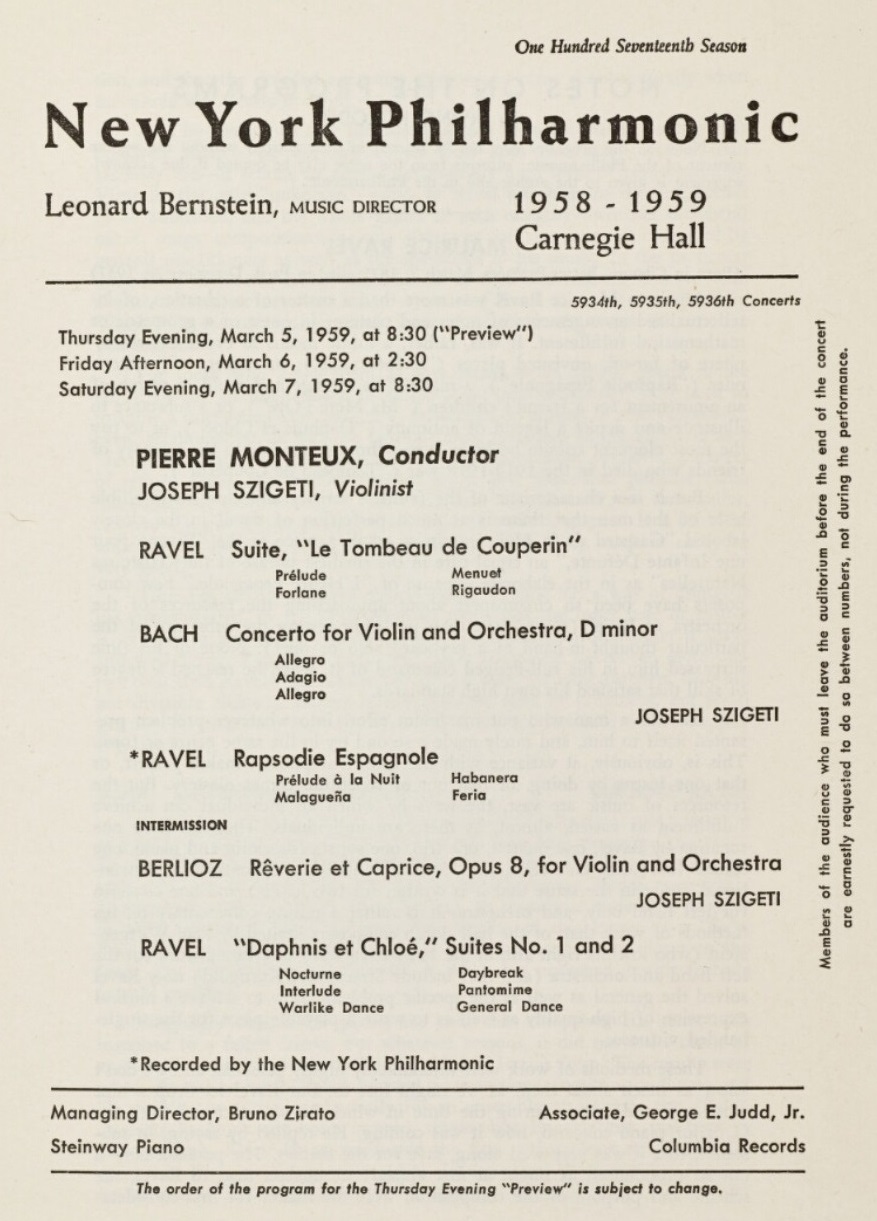
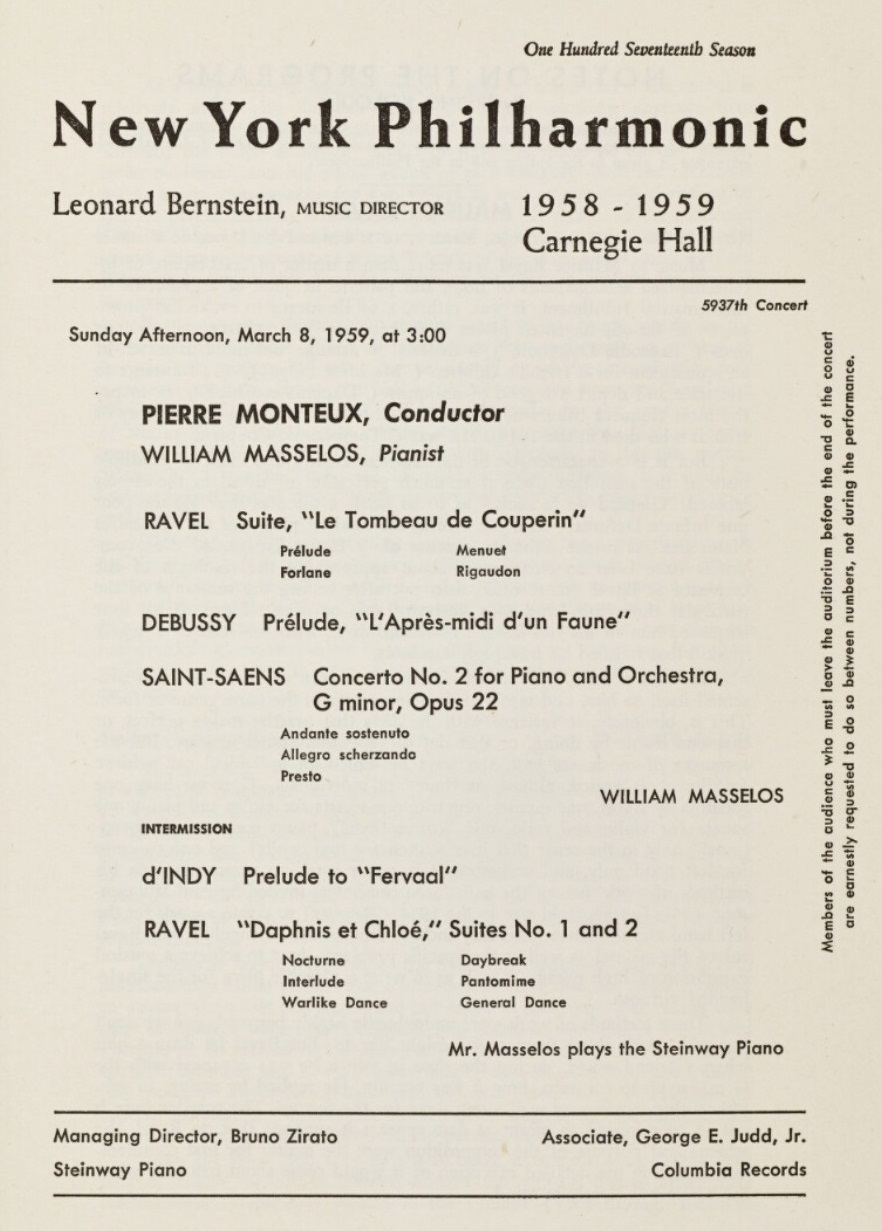
Pierre Monteux’s official discography is incomplete and for the most part late (no recording for the disc between 1947 and 1959). We know commercial recordings with the Orchestre Symphonique de Paris (OSP), the San Francisco SO (SFSO) and the London Symphony Orchestra LSO) and the 1964 Ravel LP was his very last record. In Boston, he was never invited to conduct during the Koussevitzky era. From 1951 onwards, he was in practice the orchestra’s first guest conductor. But in concert and on record, Ravel, like Berlioz, belonged first and foremost to Munch. As for the Orchestre de la Société des Concerts du Conservatoire (OSCC), Monteux did not want to continue his collaboration with this orchestra after his Stravinsky series in 1956*.
Monteux has never made a recording of Ravel’s ‘Tombeau de Couperin’. The present version with the NYPO seems to us superior to his performance with the BBC SO (October 11, 1961). It is also regrettable that there are no recordings of the two Piano Concertos which were, however, part of his repertoire .
Monteux recorded the complete ballet ‘Daphnis et Chloé’ in 1959 with the LSO and the Covent Garden Chorus. In San Francisco, he had already recorded Suite No. 1, with a chorus in the Interlude (uncredited in the re-issues)**. This New York concert with Suites Nos. 1 and 2 (without a chorus) is unique in his discography. The Interlude is thus performed in its purely orchestral version, which is very different from the one of the 1946 recording. It should also be noted that both Suites are played ‘attacca’.
The Ravel concert with the NYPO also included two works (Bach and Berlioz) played by Joseph Szigeti. At the time, his technique was not at all what it had been, and the great violinist is at a disadvantage here, which the critics did not fail to point out. It is not known whether the concert on Sunday March 8, with its different programme, was broadcast, or whether a recording of it has survived.
* In his book ‘Putting he Record Straight’, John Culshaw wrote about the recordings made by Decca and the OSCC: ‘Knappertsbusch was not inclined to force the players if they were not in the mood to give their best. Solti fought the orchestra, and they fought him back. They drove him crazy by sending deputies to play passages which had already been rehearsed, but we stilll managed to finish his programme with time on our hands… Monteux was economical with words and gestures, but he could get just what he wanted out of an orchestra – although, after our first sessions in Paris when we recorded ‘The Rite’ and ‘Petrushka’, he said he would be happier if our future ventures could be arranged in London, Amsterdam or Vienna. Even with so distinguished a musician as Monteux at the helm, the discipline of the Conservatoire Orchestra at that time was appalling, and the ‘substitute’ system just as random as it had been with Solti’.
** The program for the pair of concerts of March 15 and 16, 1946, which shortly preceded the recording with the San Francisco Symphony Orchestra (SFSO), mentions ‘Symphonic Fragments from Daphnis and Chloe First Series’ (Nocturne – Interlude – Warlike Dance) with the ‘University of California Chorus’, Pr. Edward B. Lawton, Director. In the book by Doris Monteux ‘It’s All in the Music – The Life and Work of Pierre Monteux ’, the chorus of the SFSO recording is identified as being the ‘San Francisco Municipal Chorus’.
*** Monteux performed the orchestral version of the Suites n° 1 and 2 with the SFSO on April 4 and 5, 1941, but he omitted the Interlude from Suite n°1. Charles Munch recorded both Suites in London with the OSCC on October 9, 1946, also omitting the Interlude. Wilhelm Furtwängler left a recording of both Suites with the BPO (March 20/21, 1944), but Suite no. 1 begins in the middle of the Interlude (a few bars before the flute solo), and it is likely that the omission of the Nocturne and of the beginning of the Interlude is due to the loss of part of the recording.
Les liens de téléchargement sont dans le premier commentaire. The download links are in the first comment
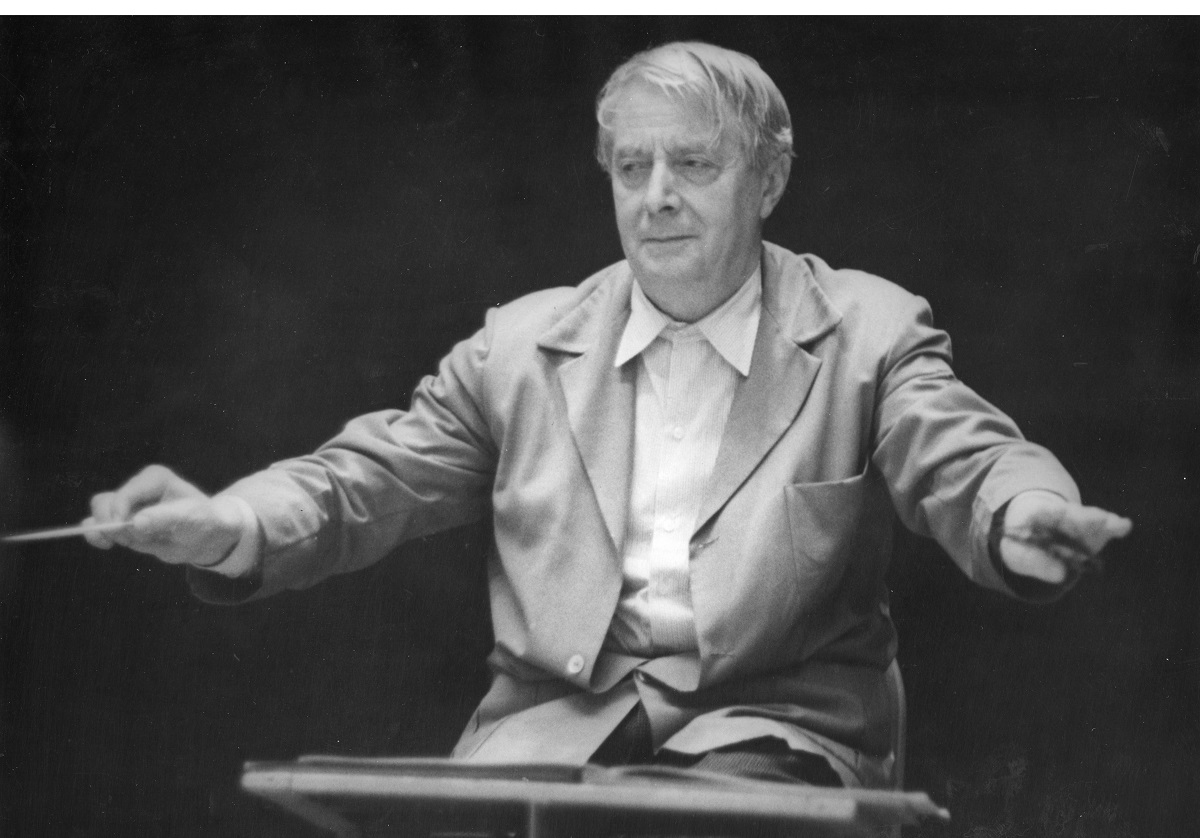
Charles Munch- Boston Symphony Orchestra (BSO)
Debussy La Mer – December 9 & 10, 1955
Ravel Rapsodie Espagnole – January 23, 1956
La Valse – December 5, 1955
____________
(Rec/Enr: Boston Symphony Hall)
Source Bande/Tape: 2 pistes/19cm/s / 2 tracks 7.5 ips STEREO
CCS-56 Debussy; CCS-36 Ravel
Ces trois œuvres font partie du cœur du répertoire de Charles Munch et il les a enregistrées plusieurs fois pour le disque. Il s’agit ici de ses premiers enregistrements en stéréo de ces œuvres. Ils ont été publiés commercialement en 1957 sous la forme de bandes magnétiques stéréophoniques, bien avant que les microsillons stéréo n’apparaissent l’année suivante.
Debussy La Mer: I Orchestre de la Société des Concerts du Conservatoire (OSCC) (Paris Studio Albert 2 mars 1942) – II BSO (Boston Symphony Hall 9 et 10 décembre 1955) – III Orchestre National de l’ORTF (Paris Studios de l’ORTF – 10 et 16 février 1968). Il existe de nombreux enregistrements publics, ce qui fait qu’en tout, on dispose d’environ vingt enregistrements dirigés par Munch!
Ravel Rapsodie Espagnole: I BSO (Boston Symphony Hall 26 décembre 1950) – II BSO (Boston Symphony Hall 23 janvier 1956) – III Orchestre de Paris (Paris Salle Wagram 21 septembre, 2 et 3 octobre 1968). Un enregistrement effectué avec l’OSCC le 16 avril 1941 n’a jamais été publié.
Ravel La Valse: I OSCC (Paris Studio Albert 3 mars et 8 octobre 1942) – II BSO (Boston Symphony Hall 11 avril 1950) – III BSO (Boston Symphony Hall 5 décembre 1955) – IV BSO (Boston Symphony Hall 26 mars 1962). L’enregistrement effectué à Boston le 1er décembre 1958 n’a pas été approuvé par Munch et n’a pas été publié.
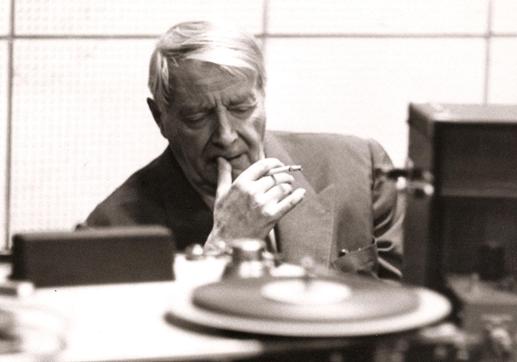


These three works are part of Charles Munch’s core repertoire, and he recorded them several times for the disc. These are his first stereo recordings of these works. They were commercially released in 1957 as stereophonic magnetic tapes, well before stereo LPs appeared the following year.
Debussy La Mer: I Orchestre de la Société des Concerts du Conservatoire (OSCC) (Paris Studio Albert March 2, 1942) – II BSO (Boston Symphony Hall December 9 & 10, 1955) – III Orchestre National de l’ORTF (Paris Studios de l’ORTF – February 10 & 16, 1968). There are many public recordings, making a total of around twenty recordings conducted by Munch!
Ravel Rapsodie Espagnole: I BSO (Boston Symphony Hall December 26, 1950) – II BSO (Boston Symphony Hall January 23, 1956) – III Orchestre de Paris (Paris Salle Wagram September 21 septembre, October 2 & 3, 1968). A recording made with the OSCC on April 16, 1941 was never released.
Ravel La Valse: I OSCC (Paris Studio Albert March 3 and October 8, 1942) – II BSO (Boston Symphony Hall April 11, 1950) – III BSO (Boston Symphony Hall December 5, 1955) – IV BSO (Boston Symphony Hall March 26, 1962). The recording made in Boston on December 1, 1958, was not approved by Munch and has not been published.

Tape Recording – November 1957 & March 1958
Les liens de téléchargement sont dans le premier commentaire. The download links are in the first comment
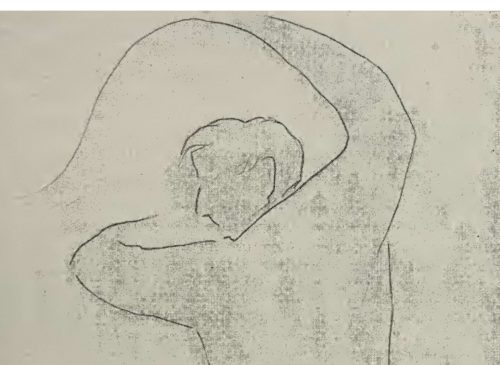
Charles Munch BSO
Berlioz Benvenuto Cellini, Ouverture Op.23
Debussy: Images n°2 Ibéria (Par les rues et par les chemins – Les parfums de la nuit – Le matin d’un jour de fête)
Ravel: Daphnis et Chloé Suite n°2 (Lever du jour – Pantomime – Danse Générale)
Boston Symphony Hall – February 12, 1965
Source: Bande/Tape 2 pistes 19 cm/s / 2 tracks 7.5 ips
Charles Munch a été le Directeur Musical du Boston Symphony Orchestra (BSO) de 1949 à 1962. Après sa démission, il est revenu chaque saison à Boston comme chef invité, en programmant des essentiellement des œuvres qui étaient au cœur de son répertoire.
C’est le cas pour ce concert de musique française qui comportait également la Quatrième Symphonie d’ Albert Roussel que nous vous avons déjà proposée.
Le présentateur William Pierce nous donne au passage les noms des solistes de l’orchestre que Munch a invités à saluer le public: Hugh Matheny,* hautbois (Berlioz, Debussy), Laurence Thorstenberg*, cor anglais (Debussy) et Doriot Anthony Dwyer, flûte (Ravel).
Munch était dans un grand jour et la prise de son est magnifique. Munchissimo….
* Nouveau membre du BSO à partir de la Saison 1964-1965.
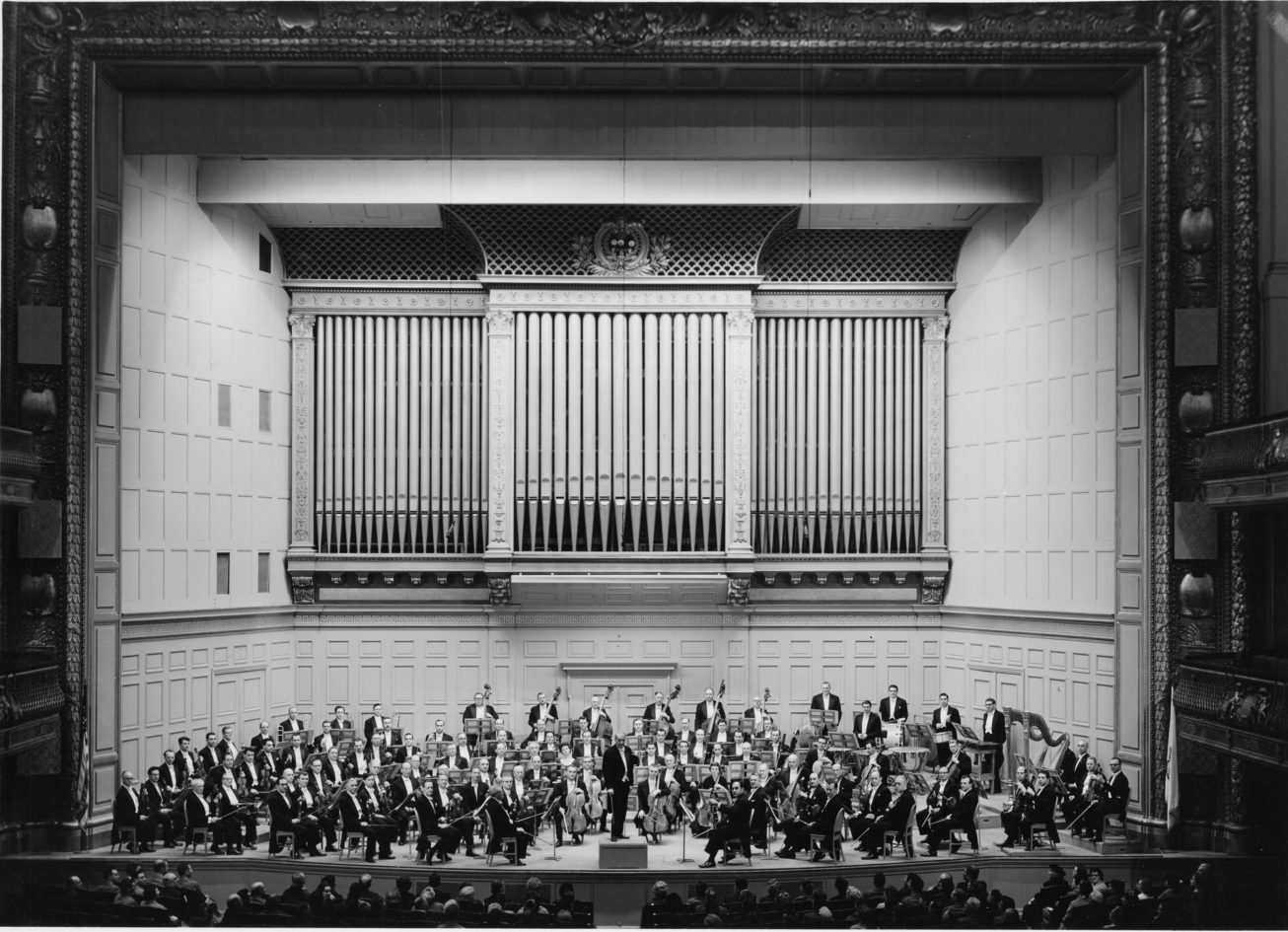
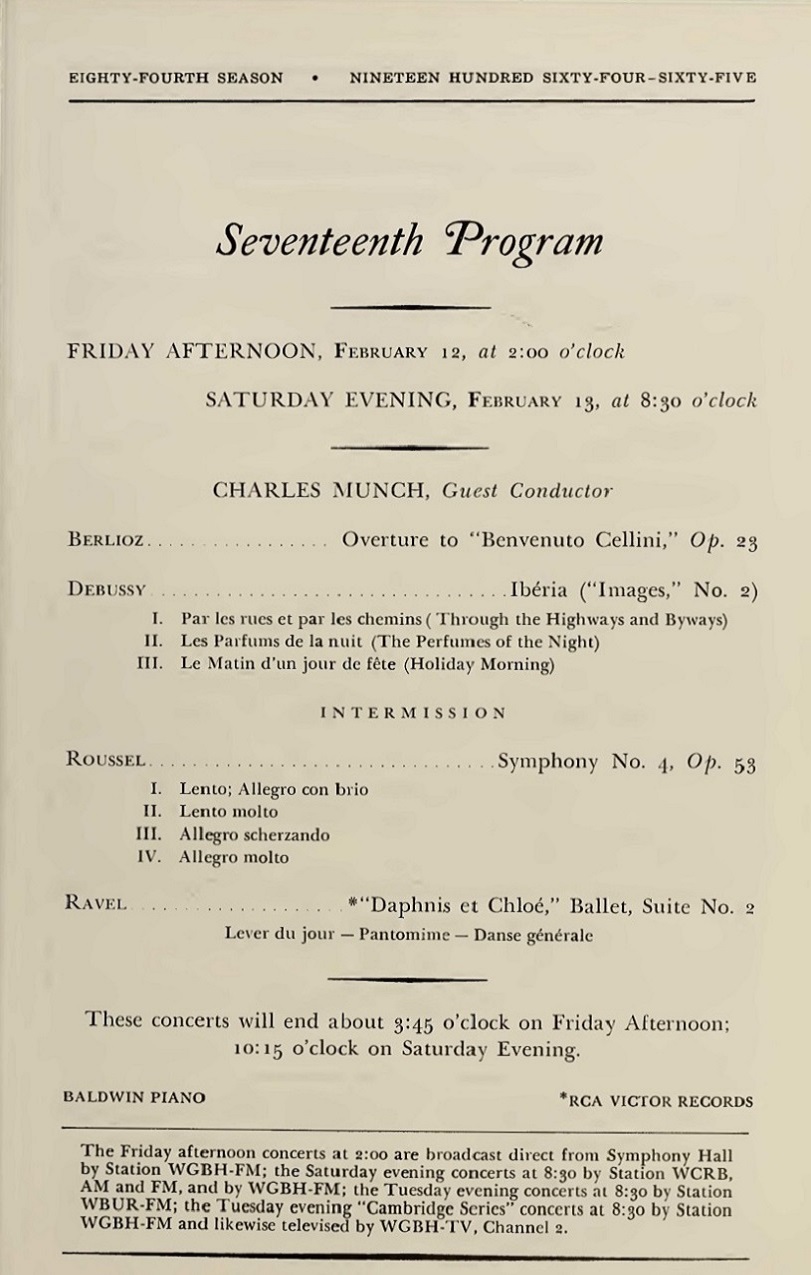
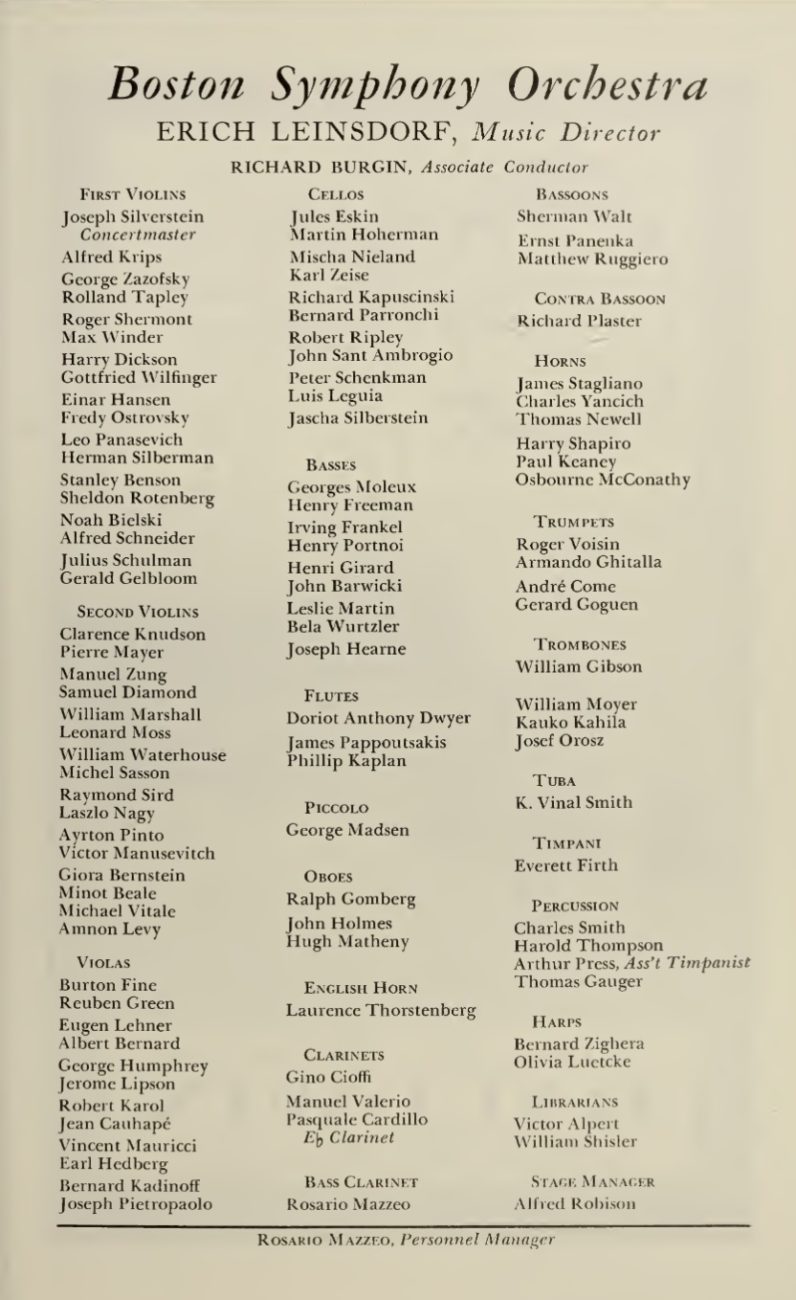
Charles Munch was Music Director of the Boston Symphony Orchestra (BSO) from 1949 to 1962. After his resignation, he returned each season to Boston as a guest conductor, programming primarily works that were central to his repertoire.
This was the case for this concert of French music, which also included Albert Roussel’s Fourth Symphony, which we have previously featured.
Presenter William Pierce gives us the names of the orchestra soloists that Munch invited to acknowledge the applause: Hugh Matheny*, oboe (Berlioz, Debussy), Laurence Thorstenberg*, English horn (Debussy) and Doriot Anthony Dwyer, flute (Ravel).
Munch was on a great day and the sound recording is magnificent. Munchissimo….
* New member of the BSO from the 1964-1965 Season.

